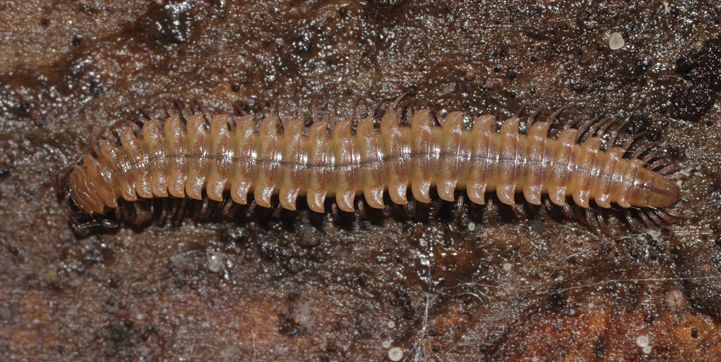|
Anthroleucosomatidae
Anthroleucosomatidae is a family of millipedes in the order Chordeumatida. These millipedes range from 3.5 mm to 28 mm in length. Adult millipedes in this family have 26, 28, 30, or 31 segments (counting the collum as the first segment and the telson as the last). This family includes ''Metamastigophorophyllon martensi'', notable as the only chordeumatidan species with 31 segments. There are about 38 genera in Anthroleucosomatidae. Genera These 38 genera belong to the family Anthroleucosomatidae: * ''Acanthophorella'' Antic & Makarov, 2016 * ''Adshardicus'' Golovatch, 1981 * ''Alloiopus'' Attems, 1951 * ''Alpinella'' Antic & Makarov, 2016 * ''Anamastigona'' Silvestri, 1898 * ''Anthroleucosoma'' Verhoeff, 1899 * ''Banatosoma'' Curcic & Makarov, 2000 * ''Belbogosoma'' Curcic & Makarov, 2008 * ''Brachychaetosoma'' Antic & Makarov, 2016 * ''Bulgardicus'' Strasser, 1960 * ''Bulgarosoma'' Verhoeff, 1926 * ''Caucaseuma'' Strasser, 1970 * ''Caucasominorus'' Antic & Makarov, 2016 * ''Corno ... [...More Info...] [...Related Items...] OR: [Wikipedia] [Google] [Baidu] |
Metamastigophorophyllon
''Metamastigophorophyllon'' is a genus of Millipede, millipedes in the Family (biology), family Anthroleucosomatidae. This genus includes millipedes found in Azerbaijan, Iran, Russia, and Georgia (country), Georgia. All five species in this genus have 31 segments in adults (counting the collum as the first segment and the telson as the last). This genus is notable for including the only species in the Order (biology), order Chordeumatida with 31 segments rather than the 30 segments usually observed in adults in this order. Discovery and taxonomy The Romanian Zoology, zoologist Traian Ceuca first proposed ''Metamastigophorophyllon'' in 1976 as a subgenus within the genus ''Mastigophorophyllon'' in the family Mastigophorophyllidae. Ceuca proposed this Monotypic taxon, monotypic subgenus to contain the species ''Mastigophorophyllon giljarovi'', which was described by the Czech zoologist Jaroslav Lang in 1959 based on Type (biology), type material found near Krasnaya Polyana, Sochi, ... [...More Info...] [...Related Items...] OR: [Wikipedia] [Google] [Baidu] |
Anamastigona
''Anamastigona'' is a genus of millipedes in the family Anthroleucosomatidae Anthroleucosomatidae is a family of millipedes in the order Chordeumatida. These millipedes range from 3.5 mm to 28 mm in length. Adult millipedes in this family have 26, 28, 30, or 31 segments (counting the collum as the first segment and the tel .... There are about 20 described species in ''Anamastigona'', found mainly in Europe and the Middle East. Species These 20 species belong to the genus ''Anamastigona'': * '' Anamastigona alba'' (Strasser, 1960) - Bulgaria * '' Anamastigona albanensis'' Mauriès, Golovatch & Stoev, 1997 - Albania * '' Anamastigona aspromontis'' (Strasser, 1970) - Italy * '' Anamastigona bilselii'' (Verhoeff, 1940) - Bulgaria, European Turkey, Greece * '' Anamastigona cypria'' Vagalinski & Golovatch, 2016 - Cyprus * '' Anamastigona delcevi'' (Strasser, 1973) - Bulgaria * '' Anamastigona falcata'' (Gulicka, 1967) - Bulgaria * '' Anamastigona halophila'' (Verhoeff, 1940) - Turk ... [...More Info...] [...Related Items...] OR: [Wikipedia] [Google] [Baidu] |
Chordeumatida
Chordeumatida (from the Greek word for "sausage") is a large order of millipedes containing some 1200 species with a nearly worldwide distribution. Also known as "sausage millipedes," they possess around 30 body segments behind the head (including the telson) as adults and reach about in length. Description Chordeumatidans are relatively short-bodied, with only 26 to 32 body segments (including the telson) behind the head. They range in length from . A key feature is the presence of 6 large bristles (setae) on the dorsal surface of each body segment. The first segment ( collum) is relatively narrow, giving the appearance of a distinct "neck" in many species. The body tapers towards the rear, and the rearmost tip (telson) contains silk-producing organs (spinnerets). A dorsal groove runs down the length of the body, and some species possess paranota, lateral extensions of the exoskeleton. Paranota are also found in some other millipedes, notably Polydesmida, from which Chordeumat ... [...More Info...] [...Related Items...] OR: [Wikipedia] [Google] [Baidu] |
Herculina
532 Herculina is a large asteroid, with a diameter of around 200 km. Discovery It was discovered on April 20, 1904, by Max Wolf in Heidelberg, and initially catalogued as 1904 NY. The origin of its name is not known; it may be named after the mythical Hercules, given a feminine form as were all asteroids at the time, or after an unknown woman of that name. The bulk of the asteroids discovered by Wolf around this date were named for characters in operas, but if this name was also drawn from such a source, no explanation has been recorded. Physical characteristics Herculina is one of the larger members of the main asteroid belt. It is believed to rank among the top 20 in size, but the exact dimensions of many large asteroids are still uncertain. The current estimate for its mass would rank it close to the top 10. It has often been noted for its complex lightcurves, which made determination of its shape and rotation somewhat difficult. A set of 1982 speckle interfer ... [...More Info...] [...Related Items...] OR: [Wikipedia] [Google] [Baidu] |
